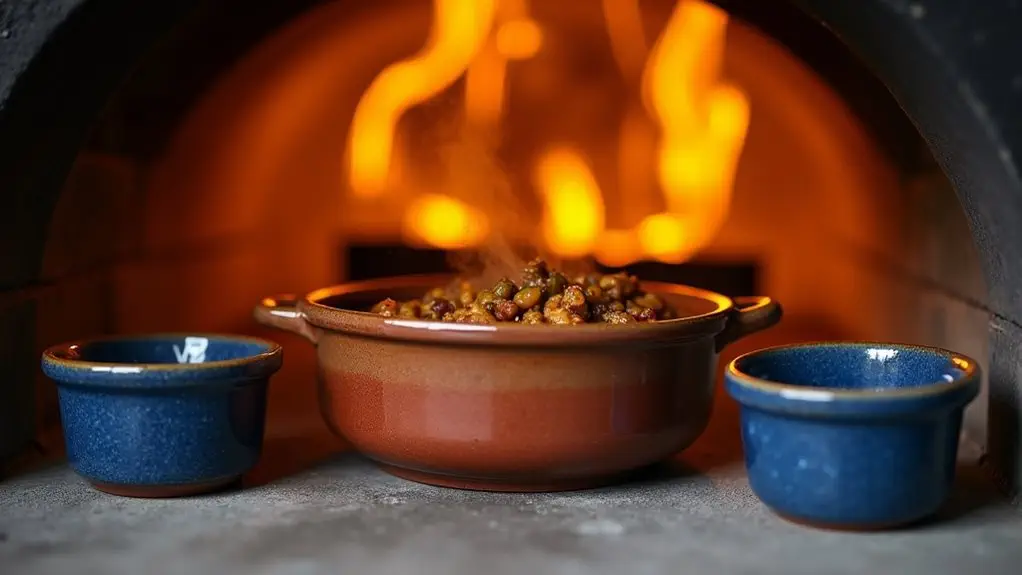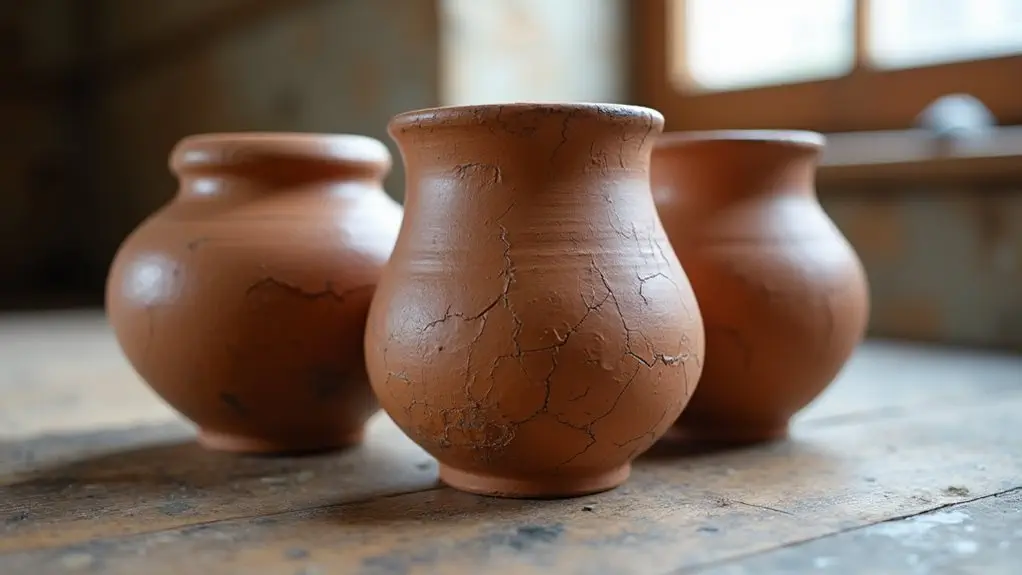You can safely use high-fired stoneware and porcelain in your oven, but not all handmade pottery is created equal. Look for pieces that are specifically labeled as oven-safe and feature a proper glaze to protect against heat and moisture. You'll want to avoid pottery with metallic decorations or any cracks, and stick to temperatures below 500°F for best results. Stoneware that's been fired at Cone 9-10 is your best bet, while terracotta requires extra care due to its porous nature. Before popping your pottery in the oven, there are some essential handling tips that'll help your pieces last longer.
Understanding Oven-Safe Pottery Materials

When choosing pottery for oven use, you'll need to understand which materials can safely withstand high temperatures and temperature fluctuations.
Different pottery types offer varying levels of ceramic durability, and knowing these differences can save you from kitchen disasters.
Stoneware and porcelain are your best bets for oven-safe options. They're fired at higher temperatures, making them dense and resistant to thermal shock. Glazed ceramics provide extra protection against heat and moisture.
Terracotta can work too, but you'll need to handle it with extra care since it's more porous.
If you're exploring ovenware options, look for pieces specifically labeled as oven-safe – they're designed to handle the heat like a champ.
Always check for those important "oven-safe" labels, and remember that your grandmother's decorative pottery with metallic trim isn't meant for baking your famous lasagna!
Temperature Limits for Handmade Ceramics
When you're working with handmade ceramics in the oven, you'll need to follow specific temperature limits based on how your piece was fired – low-fire pottery shouldn't go in the oven at all, while high-fire pieces can handle up to 500°F.
You can protect your pottery from thermal shock by placing it in a cold oven and letting it heat up gradually with the oven's temperature. Vitrified stoneware is ideal for oven use due to its enhanced durability and heat resistance achieved through mid to high-range firing.
If you're using mid-fire pottery, you'll want to keep temperatures below 400°F and always avoid sudden temperature changes that could crack your beautiful handmade pieces.
Maximum Safe Heat Levels
Understanding temperature limits is essential for safely using handmade ceramics in your oven. Different ceramic materials have varying levels of heat tolerance based on their firing techniques and ceramic durability.
For example, porcelain's high firing temperature of up to 1,400°C makes it incredibly sturdy for oven use, while earthenware needs a bit more TLC. Thicker ceramics provide better heat distribution during baking.
You'll want to stick to around 200°C (400°F) as a general rule for handmade pieces, even though they're fired at much higher temperatures. Think of it like breaking in new shoes – you'll want to be gentle at first!
Remember to always check for oven-safe labels and avoid sudden temperature changes. If you're using stoneware or porcelain, you're in luck – these tough guys handle heat like champs, but they'll still need careful preheating to prevent thermal shock.
Thermal Shock Prevention Tips
Now that you know the temperature limits for your handmade ceramics, protecting them from thermal shock becomes your next key mission.
Think of your pottery like a sleepy person who needs time to wake up – it doesn't like sudden changes! To guarantee ideal pottery durability, always start with room temperature pieces in a cold oven, then gradually heat them up.
You'll want to avoid those dramatic temperature swings that can stress your ceramics. Most stoneware can withstand temperatures of up to 2300º F when properly fired.
Don't place hot dishes on cold surfaces, and never transfer a piece straight from the freezer to a hot oven.
It's also smart to distribute food evenly across your pottery to prevent hot spots.
Preparing Pottery for Oven Use

Before putting your handmade pottery in the oven, proper preparation is essential for ensuring its longevity and preventing damage.
If you're working with unglazed pottery, you'll need to season it first – think of it as giving your pottery a protective spa treatment! Start by soaking your piece overnight in water, then bake it at 300 degrees for two hours to complete the seasoning process.
Remember to always start with room-temperature pottery, and don't place it in a pre-heated oven – that's a recipe for disaster! A second firing process in your home oven can cause thermal shock if not handled carefully.
When you're ready to cook, make sure you're distributing food evenly across the bottom of your piece.
Skip the soap when cleaning; instead, reach for vinegar or baking soda to keep your pottery in top shape for years to come.
Safety Tips and Best Practices
Once you've prepared your pottery for the oven, following key safety practices will protect both you and your handmade pieces. Your stoneware pottery pieces are especially well-suited for baking, thanks to their firing at temperatures over 2300°F.
To maximize pottery durability, never shock your pieces with sudden temperature changes – your pottery isn't a superhero that can handle going from freezing to fiery in seconds! Instead, start with your dish in a cold oven and let it warm up gradually.
When it comes to cooking techniques, you'll want to avoid placing pottery directly on stovetop burners or open flames. If you're reheating leftovers, let your pottery come to room temperature first – think of it as giving your piece a gentle wake-up call.
For cleaning, skip harsh detergents and stick to vinegar or baking soda, especially for unglazed pieces. These simple steps will keep your handmade pottery serving you beautifully for years to come.
Signs of Oven-Unsafe Pottery

While handmade pottery can add charm to your cooking, knowing how to spot unsafe pieces will protect you from potential disasters. When conducting your pottery inspections, look for telltale signs that scream "don't put me in the oven!"
Check for cracks or fissures, even tiny ones, as they'll likely expand under heat. Sudden temperature changes can cause thermal shock damage. You'll also want to watch out for faded or uneven glazes, warping, and those lovely but problematic metallic decorations.
During your oven safety assessment, don't ignore thinly crafted pieces – they're often too delicate for high temperatures. If you notice your pottery absorbs water easily or lacks clear manufacturer guidelines about oven use, it's best to keep it for serving only.
Common Pottery Types for Baking
The world of oven-safe pottery offers several reliable options for your baking adventures.
Traditional handbuilding techniques are still used today to create many of these versatile pieces. If you're exploring innovative baking techniques, stoneware's your trusty companion – it's dense, durable, and perfect for even heat distribution. You'll love how porcelain combines elegance with functionality, making it ideal for modern pottery designs that go straight from oven to table.
For those seeking traditional charm, terracotta brings an authentic touch to your baking, though you'll need to soak it first. It's perfect for crusty breads and rustic dishes.
Meanwhile, specialized ovenware's designed specifically for high-heat cooking, so you won't have to worry about thermal shock. Each type has its sweet spot in the kitchen, and once you've matched your pottery to your cooking style, you'll wonder how you ever baked without it.
Proper Care During Cooking

When you're cooking with handmade pottery, you'll need to treat your pieces with extra care to prevent temperature-related damage, starting with placing your dish in a cold oven before heating.
You can safely heat most oven-safe pottery up to 450°F, but you'll want to avoid dramatic temperature changes like placing a hot dish on a cold counter or running cold water over it. Stoneware and porcelain are the most reliable choices for oven use.
To handle hot pottery safely, always use thick oven mitts and transfer your dish to a heat-safe surface like a wooden board or cooling rack.
Temperature Change Best Practices
Properly managing temperature changes stands as the most essential aspect of using pottery in your oven. To maintain temperature stability, you'll want to let your pottery warm up naturally with your oven rather than shocking it with sudden heat. Think of your pottery like a sleepy friend – it needs time to wake up gradually!
For the best gradual heating experience, place your pottery in a cold oven and let it heat up together. If you're pulling your piece from the refrigerator, give it time to reach room temperature first. Casseroles work especially well since they promote even heat distribution.
You'll also want to guarantee your food covers the bottom evenly, which helps distribute heat uniformly throughout the piece. Remember, your handmade pottery is sturdy but sensitive – treat it with respect, and it'll serve you faithfully for years to come.
Safe Cooking Temperature Ranges
Understanding safe temperature ranges enriches your knowledge of proper pottery care during cooking.
When selecting pottery for your culinary adventures, you'll want to focus on high-fire and properly vitrified stoneware pieces, as they're your best friends in the kitchen. You can't go wrong with pottery fired at Cone 9-10, which handles those hot oven temperatures like a champ.
Your cooking techniques should always include gradual temperature changes – think of your pottery like a sleepy friend who needs time to warm up! Avoid cold surfaces when removing dishes from the oven.
Skip the earthenware for cooking (it's better suited for serving those Instagram-worthy dishes), and stick to stoneware and high-fire pieces that have been fired at Cone 4 or higher.
Remember to keep your pottery at least half-full when heating, and you'll be cooking with confidence.
Handling Hot Pottery Safely
Safe handling of hot pottery requires careful attention to temperature changes and proper techniques. When you're working with hot pieces, you'll want to avoid sudden temperature shifts that can crack or break your beautiful creations.
Start by placing your pottery in a room-temperature oven before heating, and never move it directly from hot to cold surfaces – your pottery won't appreciate the shock! Clay cookware offers even heat distribution during baking, making it ideal for consistent results.
For proper pottery handling and safe storage, remember to use protective padding between pieces and avoid freezing temperatures.
You'll want to season new pieces by soaking them in water first, and always make certain they're completely dry before storing.
When cleaning, stick to gentle methods – a mild soap and soft sponge will do the trick.
Don't forget to use protective liners for acidic foods to keep your pottery looking its best.
Maintaining Your Oven-Safe Pottery
To keep your handmade pottery performing at its best in the oven, regular maintenance and proper care are essential. Understanding pottery glazing techniques and ceramic durability factors will help you extend your pieces' lifespan.
Avoid placing your pottery on direct stovetop heat as direct heat exposure can lead to cracking.
You'll want to inspect your ceramics before each use, looking for tiny cracks that could spell disaster during baking.
After using your pottery, clean it gently with mild soap and warm water – no harsh scrubbing needed! Let it dry completely before storing, as trapped moisture can weaken the material over time.
If you've got pieces with special glazes, treat them with extra care to maintain their protective coating. Store your pottery in a safe spot where it won't get knocked around, and always follow the maker's specific care instructions.
Your oven-safe pottery will thank you with years of reliable service!
Final Thoughts
You've now got the knowledge to safely use your handmade pottery in the oven – from choosing the right clay types to monitoring temperature limits. While your favorite decorative vase won't be baking tonight's casserole, your properly crafted stoneware dish can go from fridge to oven with confidence. Remember, proper testing and care will help your oven-safe pottery pieces become treasured kitchen workhorses that'll serve you for years to come.




